#SFP28 SR Transceiver
Explore tagged Tumblr posts
Text


Elevate your network without swapping hardware: the SFP28 optical transceiver packs 25 Gbps performance into the same SFP footprint you already trust. From short-reach CWDM SR modules to long-haul LR variants, Fibrecross SFP28 delivers the density, compatibility, and reach your data center demands.
1 note
·
View note
Text
Dell M14MK 10/25gbe Dual Rate Sfp28 Sr 85c Transceiver
Dell M14MK 10/25gbe Dual Rate Sfp28 Sr 85c Transceiver, Dual-rate SFP28 transceiver for flexible connectivity options.
0 notes
Text
Sky Optics New Product 25G SFP28 Transceivers
The 25G-SR is 850nm VCSEL 25Gigabit SFP28 transceiver designed to transmit and receive optical data over 50µm duplex LC multimode optical fiber (MMF), supporting data rate of 25.78Gbps and 70m transmission distance with OM3 MMF or 100m transmission distance with OM4 MMF. It is compatible with SFP Multi-Source Agreement and SFF-8472 digital diagnostics function. For more information call us @ +8675533967196
For more details - https://www.skyoptics.cn/company-news/sky-optics-new-product-25g-sfp28-transceivers.html
0 notes
Text
BlueOptics SFP28 Transceiver 25GBASE-SR 100 Meter
Der BlueOptics BO27Q856S1D Small Form-Factor Pluggable 28 (SFP28) Transceiver mit LC Duplex Anschluss von CBO ist konzipiert für Short-Range Multimode 25 Gigabit Ethernet (25GbE) Highspeed Anwendungen von bis zu 25.78 Gigabit pro Sekunde. SFP28 SR Transceiver
0 notes
Link
SFP28 SR Transceivers
The Cisco 25GBASE SFP28 Small Form-Factor Pluggable portfolio gives clients a extensive type of high-density and low-electricity 25 Gigabit Ethernet connectivity alternatives for statistics middle and high-overall performance computing networks applications. The 25G Modules are primarily based totally on SFP28 shape factor. Buy your product module at: https://www.gbic-shop.de/bo27q856s1d-blueoptics-sfp28-transceiver-lc-duplex-25gbase-sr-multi-mode-fiber-850nm-100m
0 notes
Link
SFP28 Transceiver - Single-mode - 25GBASE-ER 1310nm 40 Kilometer - Order now!
0 notes
Text

Cisco Compatible SFP-25G-SR-S 25GBASE-SR SFP28 Transceiver
0 notes
Text
A Comprehensive Understanding of SFP Optical Transceiver
SFP optical transceiver is still being used as an industry standard by worldwide manufacturers and providers today. It has been an industry workhorse for over 20 years in many networks such as PON, WDM, Fibre Channel, SONET, and other communications standards. This paper will give you a comprehensive understanding of SFP optical transceivers.
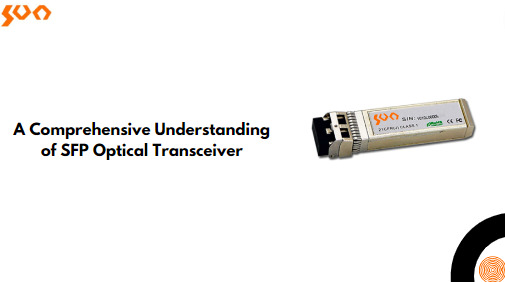
What is an SFP Optical Transceiver?
A small form-factor pluggable(SFP) optical transceiver is a hot-pluggable interface used to transmit and receive data over fiber optic cable. It consists of FP or DBF laser transmitter, a PIN photodiode integrated with a trans-impedance preamplifier (TIA), and an MCU control unit. It satisfies class-I laser safety requirements and is compatible with the SFP multi-source agreement (MSA) and SFF-8472.
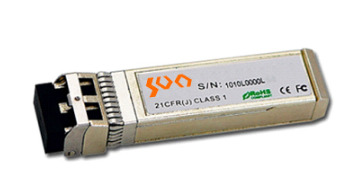
Types of SFP Optical Transceiver
Fiber Optic Cable Type
SFP optical transceiver can work over fiber optic cable and copper cable. Based on the types of fiber optic cable, SFP optical transceivers are divided into single-mode and multi-mode SFP optical transceivers. Single-mode SFP optical transceiver works with single-mode fiber. While multi-mode SFP optical transceiver works with multi-mode fiber.
Transmission Distance Range
Multi-mode SFP optical transceiver is used for shorter transmission distances up to 550m and 2km. Single-mode SFP optical transceiver is used for longer transmission distances up to 10~120km.
Transfer Rate
The trend towards higher speed and higher bandwidth is always unstoppable, from Fast Ethernet to Gigabit Ethernet, and then to 10Gb, 40Gb, 25Gb, and 100Gb Ethernet. Since the development of SFP, modernized advancements have been added to the mix. Namely, SFP+ for 10 Gigabit, SFP28 for 25 Gigabit Ethernet, QSFP for 40 Gigabit Ethernet, and QSFP28 for 100G Gigabit Ethernet are now available.
Application
3G-SDI video SFP optical transceivers are designed to meet the high standard video transmission needs in the high definition (HD) application.
PON SFP optical transceivers are used in the optical line terminal (OLT) at the central office and the optical network terminal/unit (ONT/ONU) at the subscriber’s premises.
CWDM and DWDM SFP optical transceivers are used by telecom systems in long-distance transmission, allowing them to transmit multiple signals simultaneously on a single fiber.
BIDI SFP optical transceiver transmits and receives data to interconnected network devices (like switches or routers) via a single optical fiber. It enables users to simplify their cabling system, increasing network capacity and reducing cost.
Fibre channel SFP optical transceiver is a high-speed network technology (commonly running at 1, 2, 4, 8, 16, 32, and 128 gigabits per second rates) used to connect computer data storage to servers in the SAN data center environment.
SONET/SDH SFP optical transceiver is compatible with the SONET/SDH and ATM standard, which covers the standard range of data rates extending from OC-3/STM-1 (155 Mbps) to OC-48/STM-16 (2.488Gbps) for multi-mode (MM), short-reach (SR), intermediate-reach (IR1), and long-reach (LR1/LR2) applications.
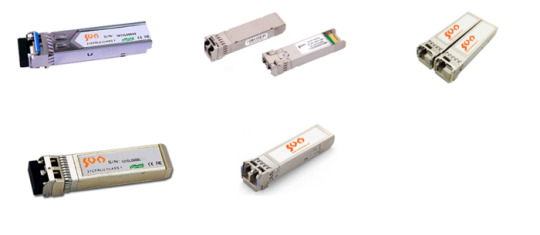
Applications
SFP optical transceiver is used in the switch-to-switch interface, router/Server interface, HD video, PON, WDM (CWDM, DWDM), data centers, telecommunications networks, etc.
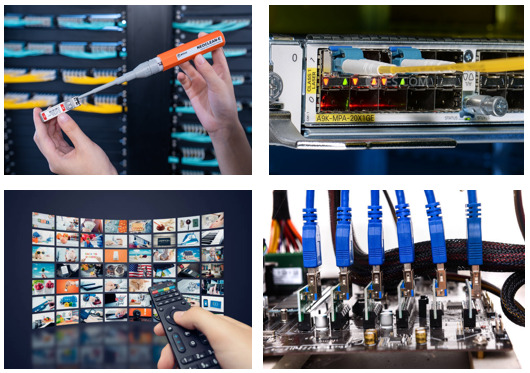
Conclusion
An SFP is a small optical transceiver that plugs into an SFP port on a network switch or server. It has a high data rate, is small in size, and is easy to use and deploy. Sun Telecom specializes in providing one-stop total fiber optic solutions for all fiber optic application industries worldwide. Contact us if any needs.
1 note
·
View note
Text
Know About QSFP28 Port Using QSFP+ Optics
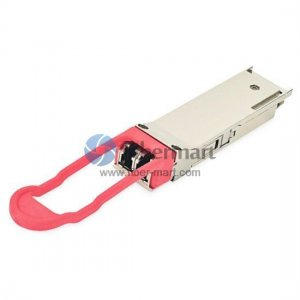
The form factor of cisco QSFP28 transceivers is the same as that of the QSFP optical transceiver. The latter supports 40G, whilst the former only provides 4 electrical lanes that may be utilized as 4x10GbE or 4x25GbE. According to all of this data, a QSFP28 module splits either 4x25G or 4x10G lanes, depending on the transceiver being utilized. The SFP28 transceivers, which run at a slower 10G speed and accept SFP+ transceivers, exhibit the same behavior.
Both QSFP+ and QSFP28 optics may often be used with a 100G QSFP28 port. The QSFP28 optics can run 4x25G breakout, 2x50G breakout, or 1x100G if they support 25G lanes. The QSFP+ optic can operate 4x10GE or 1x40GE since it supports 10G lanes. Keep in mind that there are Twinax/AOC and single-mode and multimode (SR/LR) optical transceivers available if you employ QSFP transceivers in QSFP28 ports.
QSFP28 Optics Cannot Ever Be Used on QSFP+ Port SFP+ cannot automatically negotiate to support SFP modules, and cisco QSFP cannot be utilized on a QSFP port. It boils down to the optic and the port, and vice versa, according to the rule regarding combining optical transceivers with various speeds. The form factor and both ends of the two modules must be compatible. Additionally, the port speed must match or exceed the optical speed. When selecting the best MTP trunk cable for a 40G QSFP+ SR4/CSR4 transceiver connection, there are several other aspects to take into account in addition to employing an MTP 8-fiber or MTP 12-fiber trunk cable.

Conclusion In conclusion, QSFP+ modules can be utilized on QSFP28 ports however QSFP28 transceivers are unable to transmit 100Gbps on QSFP+ ports. Don't forget to set up your switch before utilizing the QSFP optics on the QSFP28 port. We must select a female-female MTP trunk cable if we wish to properly link a 40G QSFP+ SR4 transceiver to another 40G QSFP+ SR4 transceiver. We must choose a type B MTP 8-fiber or MTP 12-fiber trunk cable under the IEEE 40GBASE-SR4 requirements. You must make sure that the connections on both ends are identical and that there are no problems with manufacturer compatibility to guarantee a smooth network transfer. You can opt for cisco SFP.
Main source: https://fibermart.weebly.com/
1 note
·
View note
Text
QSFP28 vs. SFP28: what’s the difference?
1. Basic information
SFP28 optical transceiver, also known as 25G SFP28, is an optical module with a transmission rate of 25Gbps, which is mainly used in 25G Ethernet and 100G Ethernet. It has the advantages of low power consumption, high port density and saving network deployment cost. QSFP28 optical transceiver, also known as 100G QSFP28, is an important part of 100G network. It is mainly used in 100G Ethernet and edrinfinitband applications. It uses four 25Gbit/s transmission channels to transmit data.
2. Technological development
SFP28 optical transceiver is mainly used for the interconnection of data center servers and switches. It is a new Ethernet standard with many advantages. It was proposed by IEEE 802.3 working group and all revised in 2016. The advantage of 25G Ethernet technology is that it can maximize bandwidth and port density. It can realize 100GB data transmission through 25Gb/s single channel physical layer technology.
3. What is SFP28?
·Compared with 10G optical module, 25G SFP28 optical module has the best input/output performance and optical fiber capacity of 2.5 times, higher port density, and can save operation cost by reducing the number of tor switches and cables;
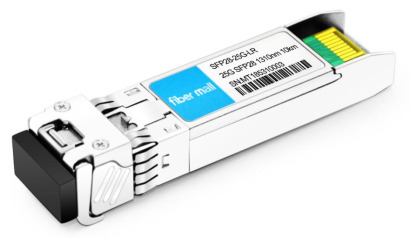
Fiber Mall SFP28 LR Module
·Compared with 40G optical module, the cost of SFP28 optical module is small, because SFP28 optical module can use two optical channels to achieve 50G transmission rate, while 40G optical module needs to achieve 40G transmission rate through four 10G Optical channels;
·Compared with 100G optical module, the loss of SFP28 optical module is smaller.
How many types of SFP28 transceiver?
SFP28 is mainly divided into SFP28 SR and SFP28 LR optical module.
The SFP28 SR optical module complies with multiple standards and specifications such as IEEE 802.3, SFF-8472, SFF-8402, SFF-8432 and SFF-8431, etc. It is an SFP28 optical module with a center wavelength of 850nm and supports DOM (Digital Optical Monitoring) function, which helps network management to monitor the information of optical modules in real time, unlike other Unlike other SFP28 optical modules, the SFP28 SR optical module needs to be used with OM3/OM4 multimode fiber of 50/125µm fiber diameter because the internal transmitter of the SFP28 SR optical module is a vertical cavity surface emitting laser, which makes the SFP28 SR optical module suitable for short distance data transmission (the longest transmission distance is at 100m), and can be used in 25G Ethernet switches, switches, and switches. It can be used for short distance data transmission in 25G Ethernet switches, routers, network interface cards (NICs) and storage network devices.
SFP28 LR optical module also conforms to multiple standards and specifications such as IEEE 802.3, SFF-8472, SFF-8402, SFF-8432 and SFF-8431, etc. It is an SFP28 optical module with a central wavelength of 1310nm, and the transmission distance can reach 10km when used together with single-mode fiber. The SFP28 LR optical module is mainly used for long-distance data transmission (the longest transmission distance can reach 10㎞), and it is different from the SFP28 LR optical module in that the SFP28 LR optical module uses a DFB laser.
4. How many types of QSFP28 transceiver?
l QSFP28 SR4: it is also known as 100GBASE-SR4QSFP28 optical module, because most of the multimode fiber used in data centers, IEEE has developed a standard for 100GQSFP28 optical module that specifically supports multimode fiber for short distance transmission applications: 100GBASE-SR4. QSFP28 SR4 optical module uses MTP interface (8 cores), and the transmission distance is 70m when used with OM3 multimode fiber and 100m when used with OM4 multimode fiber, which is suitable for short-distance transmission. QSFP28 SR4 optical modules belong to parallel 100G optical modules, which have advantages such as high port density and low cost. But different brands may name it differently, for example, Cisco’s QSFP28 SR4 is actually called QSFP-100G-SR4-S.
l QSFP28 LR4: it is also known as 100GBASE-LR4QSFP28 optical module, for 100G long distance transmission, IEEE has developed 100GBASE-LR4 standard for 100GQSFP28 optical module.QSFP28LR4 optical module also uses 4 fiber channels, the difference is that it introduces WDM technology, which can multiplex 4 The QSFP28LR4 optical module also uses 4 fiber channels, but the difference is that it introduces WDM technology, which can multiplex different wavelengths of 4 fiber channels onto a single fiber for transmission. Therefore, the QSFP28LR4 optical module uses a duplex LC interface and can reach a transmission distance of 10km when used with single-mode fiber, providing a solution for the ever-increasing transmission distance needs of ultra-large data centers.

l QSFP28 PSM4: it is also known as 100GBASE-PSM4QSFP28 optical module, has a hot-swappable QSFP form factor, built-in digital diagnostics, high speed and low power consumption. 100GBASE-PSM4 is a multi-source agreement (MSA), mainly developed for 100GQSFP28 optical modules. QSFP28 PSM4 optical module is mainly used for medium and long distance transmission applications with MTP interface, and the transmission distance can reach 500m when used with single-mode multi-core fiber, and it has eight fibers, each with a data rate of 25Gbps.
l QSFP28 CWDM4: it is also known as 100GBASE-CWDM4QSFP28 optical module, mainly used in computing, high frequency trading, etc. 100GBASE-CWDM4 is also a multi-source agreement (MSA), QSFP28 CWDM4 optical module also introduced WDM technology, using LC duplex interface, when used with single-mode fiber the transmission distance can reach 2km when used with single-mode fiber.
0 notes
Photo

Jl293a Hp X190 25g Sfp28 Lc Sr 100m Mm Transceiver For Optical Network, Data Networking 1 Lc 25gbase-sr Network Optical Fiber Multi-mode 25 Gigabit Ethernet 25gbase-sr JL293A JL293A HP X190 25G SFP28 LC SR 100m MM Transceiver For Optical Network, Data Networking 1 LC 25GBase-SR Network Optical Fiber Multi-mode 25 Gigabit Ethernet 25GBase-SR.
0 notes
Text
25G Transceiver FAQ
Written by Craig Pasek, Product Manager, Transceiver Modules Group
I’ve posted a few blogs about 25G transceivers (here, here, and here). Here’s an FAQ to address questions that have arisen from the significant uptick in the use of 25G transceivers, which is driven by high bandwidth demands in enterprise, data center and service provider applications.
Q: Why is the use of 25G increasing?
Many network operators have chosen 25G instead of multiple 10G’s, because 25G provides 2.5x bandwidth of the 10G in the same familiar SFP form factor at approximately the same power. This has enabled network equipment manufacturers to provide higher bandwidth connectivity. Rack mountable switches and routers populated with 12 ports, 24 ports, and 48 ports on a single 1 RU faceplate are common for SFP.
Q: What is the cost per bit of 25G?
25G provides 2.5x the bandwidth of 10G at a slight increase in cost. The result is nearly a 50% reduction in the cost per bit.
Q: Is 25G standardized?
The IEEE (Institute of Electrical and Electronic Engineers) has standardized 25G. See IEEE802.3by and IEEE802.3cc for the details.
Q: Which popular 25G transceivers are available today ?
MMF (Multi Mode Fiber): SFP-10/25G-CSR-S (up to 400m on OM4) SFP-25G-SR-S (up to 100m on OM4)
SMF (Single Mode Fiber): SFP-10/25G-LR (up to 10km)
Cables: SFP-25G-AOCxxM (up to 10m) SFP-H25G-CUxM (up to 5m)
Q: What is SFP28?
SFP28 is the standardized pluggable form factor for 25G transceivers. It has the same mechanical dimensions as 10G SFP+ and 1G SFP. The electrical interface of 25G was envisioned to operate up to 28Gbps to accommodate overhead for a 25Gbps signal. Today most 25G transceivers operate at a 25.78125Gbps nominal data rate. The standards body that defines SFP28 is SFF (Small Form Factor Committee).
Q: What is SR?
SR is Short Reach, and generally refers to transceivers that operate over MMF up to a few 100 meters.
Q: What is LR?
LR is Long Reach, and generally refers to transceivers that operate over SMF at up to 10km.
Q: What does “AOC” mean?
AOC is Active Optical Cable. These cables are generally 1 to 10 meters in length and have active components that connect SFP28 hosts at 25G.
Q: What does “DAC” mean?
DAC is Direct Attached Cable. These cables are generally 1 to 5 meters in length and are passive.
Q: What does “10/25G” mean?
These are dual-rate transceivers that support both 10G and 25G rates.
Q: Explain “CSR”
“Cisco Short Reach” is Cisco technology that enables reach of 300/400m over OM3/4 MMF.
Note: The IEEE standard 25G SR’s reach is only up to 70/100m over OM3/4 MMF.
Q: What does “breakout” mode mean?
Breakout enables multilane QSFP transceivers to interoperate with single lane SFP transceivers.
For example, up to 4x SFP-25G-SR-S can interoperate with a QSFP-100G-SR4-S using a MMF breakout cable; 4x SFP-10/25G-LR-S interoperates with a QSFP-4X10G-LR-S (at 10G) and a QSFP-100G-PSM4-S (at 25G) using SMF breakout cable; and 4x SFP-10/25G-CSR-S interoperates with a QSFP-40G-SR4-S (at 10G) or a QSFP-100G-SR4-S (at 25G) using a MMF breakout cable.
Q: What new technology is in 25G transceivers?
25G transceivers have CDR (Clock Data Recovery) circuits and generally require FEC (Forward Error Correction).
Q: When is FEC needed?
FEC decreases the BER to 10-12. For 25G, RS-FEC is used when the pre-FEC BER is above 5×10-5 and FC-FEC is used when the pre-FEC BER is above 10-8. Additional details can be found in IEEE802.3 Clause 74 for FC-FEC and Clause 91 for RS-FEC.
Q: What is BER?
BER refers to Bit Error Rate.
Q: What Cisco host platforms support 25G transceivers ?
See the Cisco transceiver Compatibility Matrix: https://tmgmatrix.cisco.com/home
Q: Where can additional information about Cisco 25G transceivers be found ?
See the Cisco 25G datasheet: https://www.cisco.com/c/en/us/products/collateral/interfaces-modules/transceiver-modules/datasheet-c78-736950.html
25G Transceiver FAQ published first on https://brightendentalhouston.tumblr.com/
0 notes
Link
Are you looking to purchase a BlueOptics SFP28 Transceiver 25GBASE-SR 100 Meter online at an affordable price? Just get in touch with the Gbic-shop.de, it is the best online shopping platform for active and passive components for fiber and copper networks. We exclusively offer high-quality brand products of CBO, whose components are highly tested and manufactured to international standards. We have a skilled and dedicated customer care team that responds to the customer`s query quickly. Book your product at: https://www.gbic-shop.de/bo27q856s1d-blueoptics-sfp28-transceiver-lc-duplex-25gbase-sr-multi-mode-fiber-850nm-100m
0 notes
Text
25G Transceiver FAQ
Written by Craig Pasek, Product Manager, Transceiver Modules Group
I’ve posted a few blogs about 25G transceivers (here, here, and here). Here’s an FAQ to address questions that have arisen from the significant uptick in the use of 25G transceivers, which is driven by high bandwidth demands in enterprise, data center and service provider applications.
Q: Why is the use of 25G increasing?
Many network operators have chosen 25G instead of multiple 10G’s, because 25G provides 2.5x bandwidth of the 10G in the same familiar SFP form factor at approximately the same power. This has enabled network equipment manufacturers to provide higher bandwidth connectivity. Rack mountable switches and routers populated with 12 ports, 24 ports, and 48 ports on a single 1 RU faceplate are common for SFP.
Q: What is the cost per bit of 25G?
25G provides 2.5x the bandwidth of 10G at a slight increase in cost. The result is nearly a 50% reduction in the cost per bit.
Q: Is 25G standardized?
The IEEE (Institute of Electrical and Electronic Engineers) has standardized 25G. See IEEE802.3by and IEEE802.3cc for the details.
Q: Which popular 25G transceivers are available today ?
MMF (Multi Mode Fiber): SFP-10/25G-CSR-S (up to 400m on OM4) SFP-25G-SR-S (up to 100m on OM4)
SMF (Single Mode Fiber): SFP-10/25G-LR (up to 10km)
Cables: SFP-25G-AOCxxM (up to 10m) SFP-H25G-CUxM (up to 5m)
Q: What is SFP28?
SFP28 is the standardized pluggable form factor for 25G transceivers. It has the same mechanical dimensions as 10G SFP+ and 1G SFP. The electrical interface of 25G was envisioned to operate up to 28Gbps to accommodate overhead for a 25Gbps signal. Today most 25G transceivers operate at a 25.78125Gbps nominal data rate. The standards body that defines SFP28 is SFF (Small Form Factor Committee).
Q: What is SR?
SR is Short Reach, and generally refers to transceivers that operate over MMF up to a few 100 meters.
Q: What is LR?
LR is Long Reach, and generally refers to transceivers that operate over SMF at up to 10km.
Q: What does “AOC” mean?
AOC is Active Optical Cable. These cables are generally 1 to 10 meters in length and have active components that connect SFP28 hosts at 25G.
Q: What does “DAC” mean?
DAC is Direct Attached Cable. These cables are generally 1 to 5 meters in length and are passive.
Q: What does “10/25G” mean?
These are dual-rate transceivers that support both 10G and 25G rates.
Q: Explain “CSR”
“Cisco Short Reach” is Cisco technology that enables reach of 300/400m over OM3/4 MMF.
Note: The IEEE standard 25G SR’s reach is only up to 70/100m over OM3/4 MMF.
Q: What does “breakout” mode mean?
Breakout enables multilane QSFP transceivers to interoperate with single lane SFP transceivers.
For example, up to 4x SFP-25G-SR-S can interoperate with a QSFP-100G-SR4-S using a MMF breakout cable; 4x SFP-10/25G-LR-S interoperates with a QSFP-4X10G-LR-S (at 10G) and a QSFP-100G-PSM4-S (at 25G) using SMF breakout cable; and 4x SFP-10/25G-CSR-S interoperates with a QSFP-40G-SR4-S (at 10G) or a QSFP-100G-SR4-S (at 25G) using a MMF breakout cable.
Q: What new technology is in 25G transceivers?
25G transceivers have CDR (Clock Data Recovery) circuits and generally require FEC (Forward Error Correction).
Q: When is FEC needed?
FEC decreases the BER to 10-12. For 25G, RS-FEC is used when the pre-FEC BER is above 5×10-5 and FC-FEC is used when the pre-FEC BER is above 10-8. Additional details can be found in IEEE802.3 Clause 74 for FC-FEC and Clause 91 for RS-FEC.
Q: What is BER?
BER refers to Bit Error Rate.
Q: What Cisco host platforms support 25G transceivers ?
See the Cisco transceiver Compatibility Matrix: https://tmgmatrix.cisco.com/home
Q: Where can additional information about Cisco 25G transceivers be found ?
See the Cisco 25G datasheet: https://www.cisco.com/c/en/us/products/collateral/interfaces-modules/transceiver-modules/datasheet-c78-736950.html
25G Transceiver FAQ published first on https://medium.com/@JioHowpage
0 notes
Text
0 notes
Link
BlueOptics© SFP28 Transceiver, LC-Duplex, 25GBASE-SR, Multimode Fiber, 850nm, 100M, 0°C/+70°C, DDM
0 notes